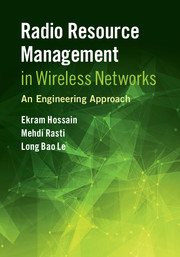Book contents
- Frontmatter
- Contents
- Preface
- Part I Basics of Wireless Networks
- Part II Techniques for Modeling and Analysis of Radio Resource Allocation Methods in Wireless Networks
- Part III Physical Layer Resource Allocation in Wireless Networks
- Part IV Link Layer Resource Allocation in Wireless Networks
- Part V Cross-Layer Modeling for Resource Allocation in Wireless Networks
- 13 Joint PHY/RLC Design in Cellular Wireless Networks
- Index
- References
13 - Joint PHY/RLC Design in Cellular Wireless Networks
from Part V - Cross-Layer Modeling for Resource Allocation in Wireless Networks
Published online by Cambridge University Press: 11 May 2017
- Frontmatter
- Contents
- Preface
- Part I Basics of Wireless Networks
- Part II Techniques for Modeling and Analysis of Radio Resource Allocation Methods in Wireless Networks
- Part III Physical Layer Resource Allocation in Wireless Networks
- Part IV Link Layer Resource Allocation in Wireless Networks
- Part V Cross-Layer Modeling for Resource Allocation in Wireless Networks
- 13 Joint PHY/RLC Design in Cellular Wireless Networks
- Index
- References
Summary
Introduction
Design and analysis of ARQ and HARQ protocols for error control in the wireless environment has been a very active research topic over several decades. While the ARQ protocols simply aim at retransmitting erroneous packets to achieve the desired reliability, HARQ protocols jointly exploit physical layer techniques including diversity combining, error control coding, and retransmission mechanisms of traditional ARQ protocols to achieve better performance. In particular, HARQ protocols are usually more throughput and delay efficient than ARQ protocols since HARQ protocols adaptively adjust the redundancy level on the fly to achieve reliable data transmission. Moreover, HARQ protocols are able to exploit useful information accumulated over different transmission attempts to efficiently decode data, which are typically overlooked by ARQ protocols.
Much research has been conducted to develop efficient ARQ and HARQ protocols for wireless channels with different characteristics such as large round trip delay, high loss rate, and long bursts of errors. For HARQ protocols, devising a suitable coding strategy to be employed with the underlying retransmission and decoding mechanisms has been of great interest. Moreover, performance analysis of ARQ and HARQ protocols over different communication channels such as channels with independent and identically distributed (i.i.d.) and correlated error patterns has resulted in large body of literature. More recently, there has been interest in jointly designing ARQ/HARQ protocols with advanced physical layer techniques such as adaptive modulation and coding.
This chapter covers fundamental design and analysis aspects of ARQ and HARQ protocols. Different types of ARQ and HARQ protocols with their own characteristics are described and highlighted. In addition, we will discuss important models for performance analysis and cross-layer design of different ARQ and HARQ protocols over diverse communication channels. While Chapter 2 mainly described the throughput of basic ARQ protocols in communication environments with simple error patterns, the analysis presented in this chapter considers error-prone wireless channels with different characteristics.
- Type
- Chapter
- Information
- Radio Resource Management in Wireless NetworksAn Engineering Approach, pp. 379 - 414Publisher: Cambridge University PressPrint publication year: 2017



